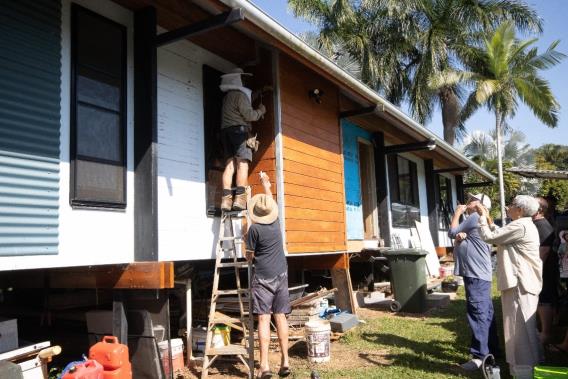The CCNBA met at South Mission Beach this month, to attempt to transfer several of what we believe to be clypearis hives, located in the walls of a house being renovated. Members were invited to bring a hive box for transfer. We ended up with such a variety of boxes that we decided to begin the meeting with an analysis of the features of the boxes and then moved onto complete the transfer of hives.
The key discussion points regarding the boxes were volume, design properties to support good insulation and box preparation.
Several of the boxes had a volume of 3 to 5 L which is not ideal for a smaller colony transfer of clypearis bees. A volume of 1 or 2 L seems to be a good fit for this species which thrive in extremely small spaces, especially the walls of house in the wet tropics.
The importance of well insulated boxes was also dis-cussed. A few of the hives had very thick walls but a thin top and base which we predicted would not necessarily give the best heat insulation in the tropics. Some of the hives had a polyurethane finish and others were painted white. The polyurethane provides good water proofing, and hence rot resistance, but we were unsure of it’s potential to reflect heat whereas the white paint definitely is heat resistant but may be less resilient to rot in the wet season. This in turn lead us to all agree that some type of hive roof is most important and useful, and hive location in our yard is also extremely important.
Options for lining the hives with propolis were demonstrated and pest protection and options for adding a layer of mesh at the base to allow for honey drain from bro-ken pots was also explained.
The group then observed and counted the hive entries, and made predictions about species and what we would find in the walls.
Bees were captured, cooled in the fridge and photo-graphed to assist in identification. It was suggested that we may also have one or two Austroplebeia hives due to the extreme length of a few entrance tubes. There were also 3 distinct hive entrance tubes. Unfortunately, we were unable to conclusively identify the species so more knowledge and learning is needed by us all in regard to ID.






The wall removal began with the removal of metal flashing and a ply wall.
Everyone was expecting the walls to be chock a block full but most of us were shocked to see such small hives. We were astounded at how the bees could set up a nest in such narrow spaces and in the metal flashing on a very hot west facing wall. Hives were also located between timber joins.
Brood and pots from 3 hives were transferred into boxes and the boxes left for a few days at the old hive entrances before being closed up and removed.
The wall hive transfer was a great afternoon. We have many “newbees” attending our meetings and this one was particularly informative and enlightening.
A big thank you is extended to Zoe Holmes for allowing us to take over her home for the afternoon, Shane Holmes for doing the demolition work on the walls and Jane Frost for the great photos.
A reminder that our AGM will be held on Saturday Octo-ber 1 at El Arish Tavern from 1pm to 3pm, with the kitch-en open for the purchase of lunch.
Agenda: election of new committee, planning for the future and a short presentation “All about brood”.
If you are attending please Email busylizzy.lang@gmail.com, or go to our Facebook page, find the event and click “Going”.
From: Liz Lang, Secretary / Treasurer
Cassowary Coast Native Bee Association Facebook page, https://www.facebook.com/groups/1703605019824793/

